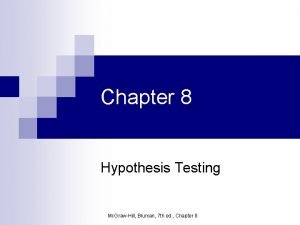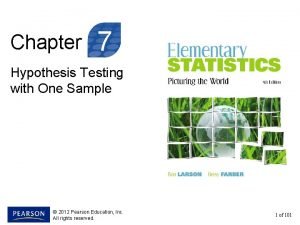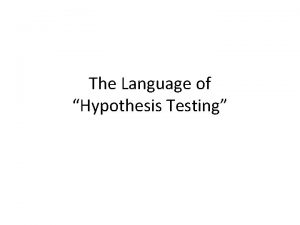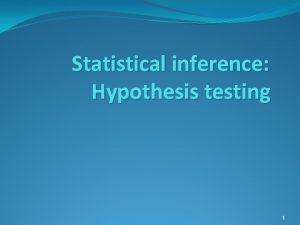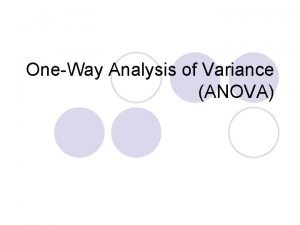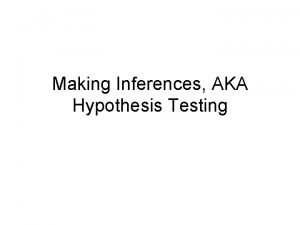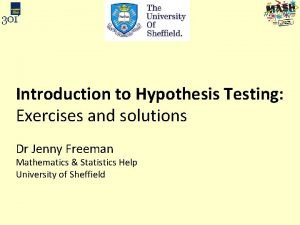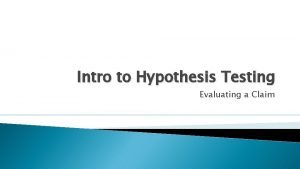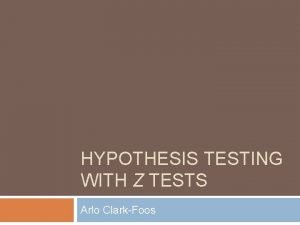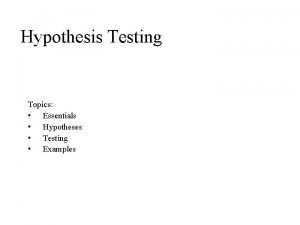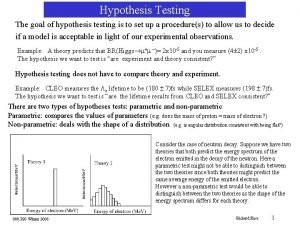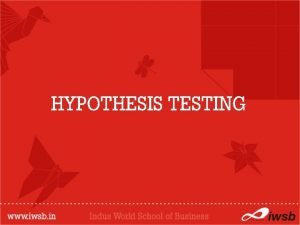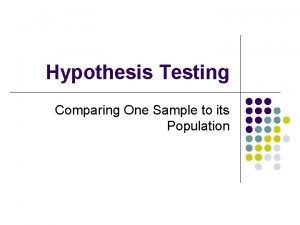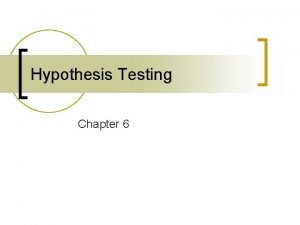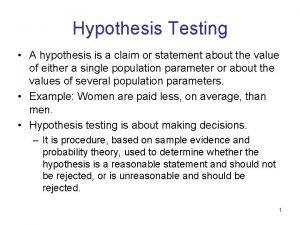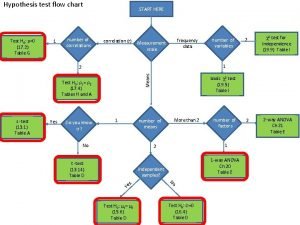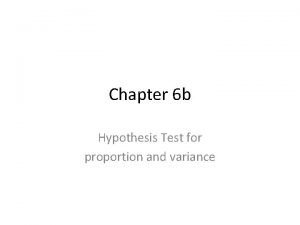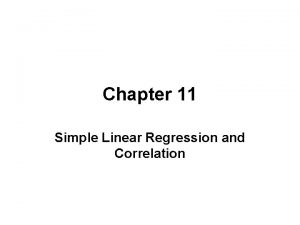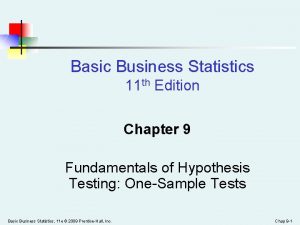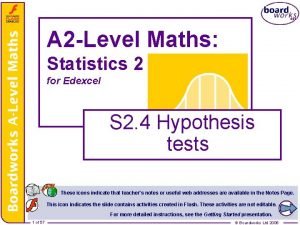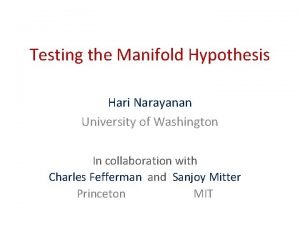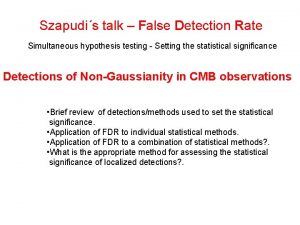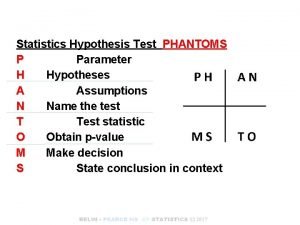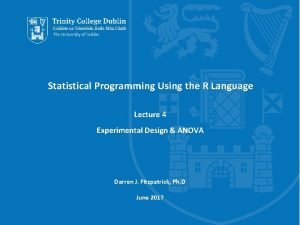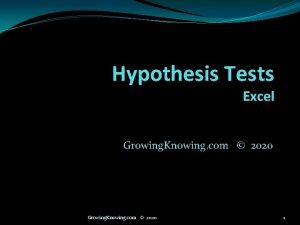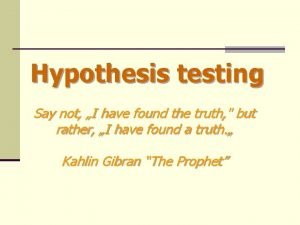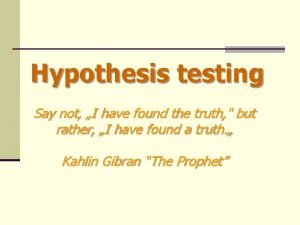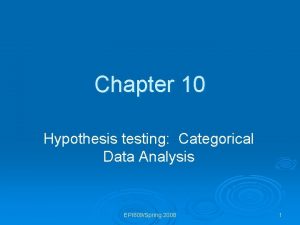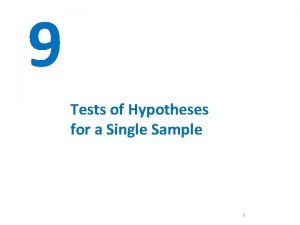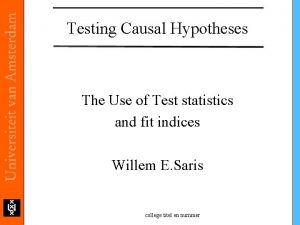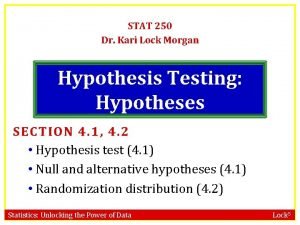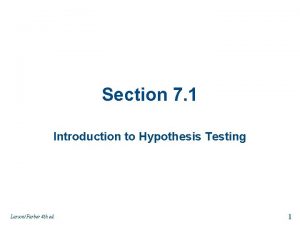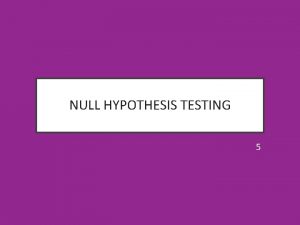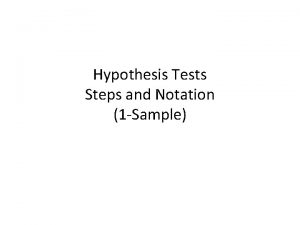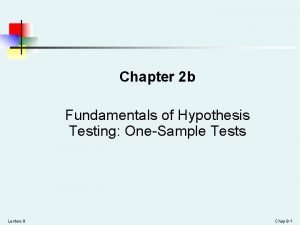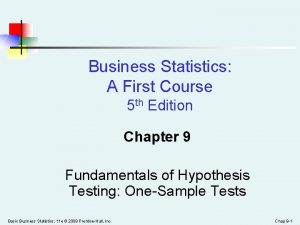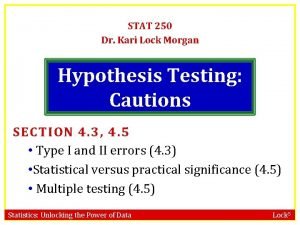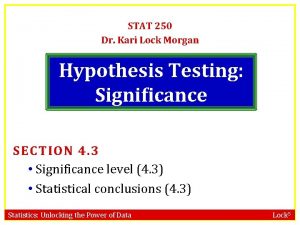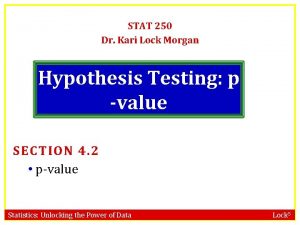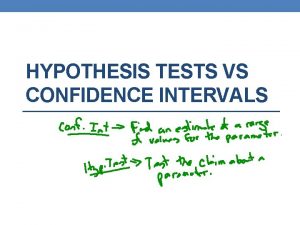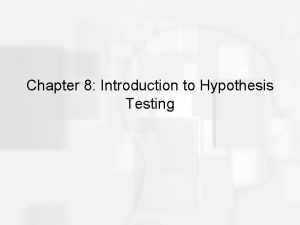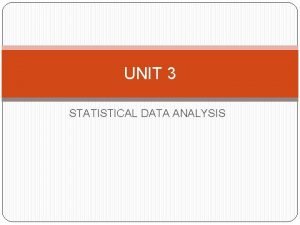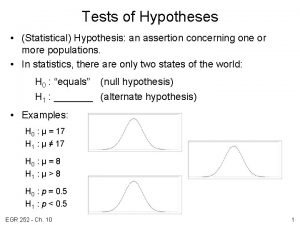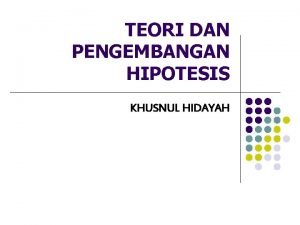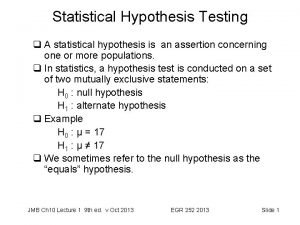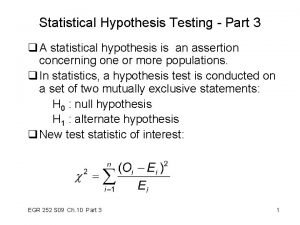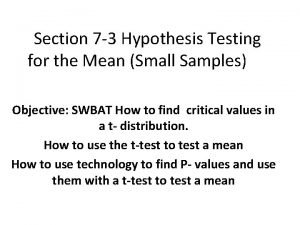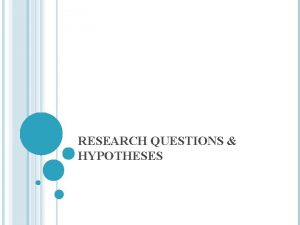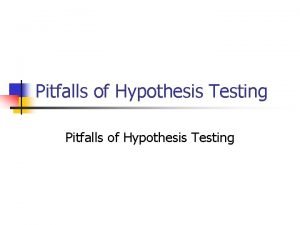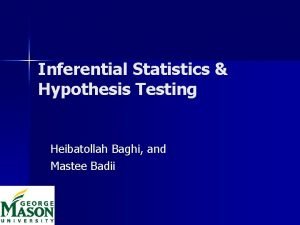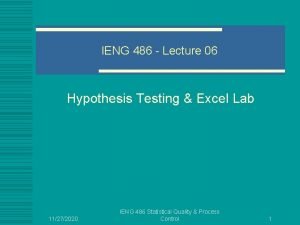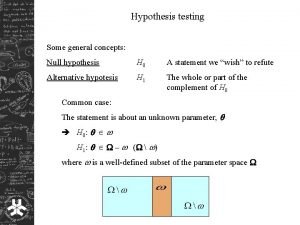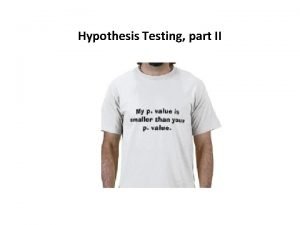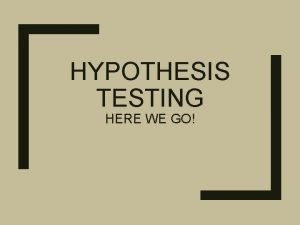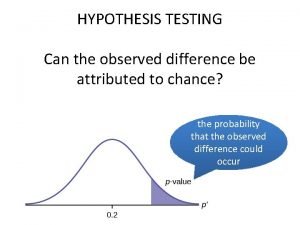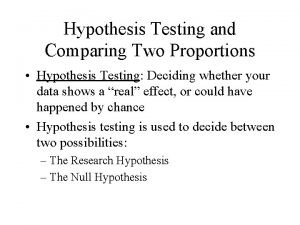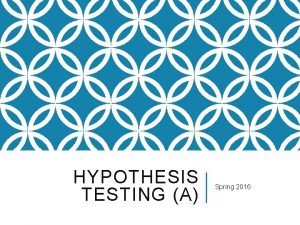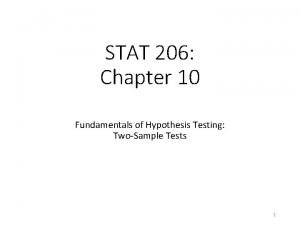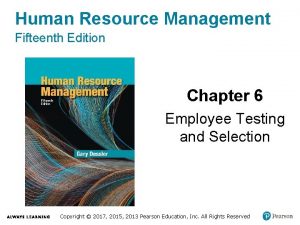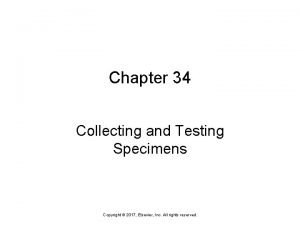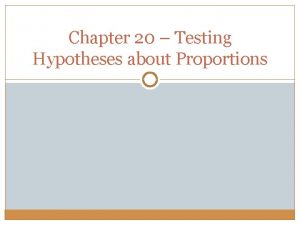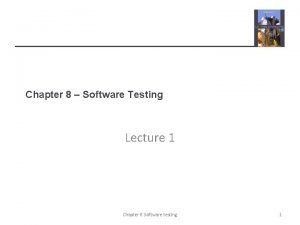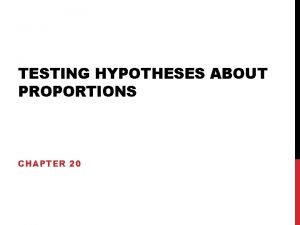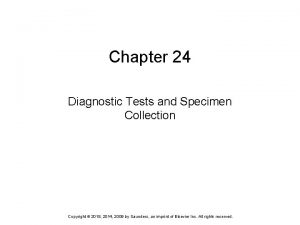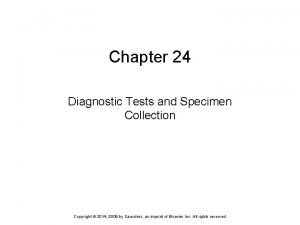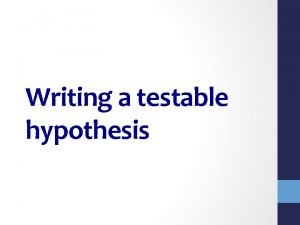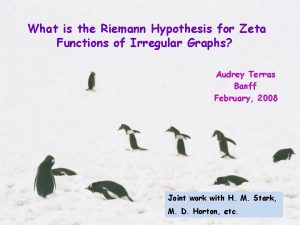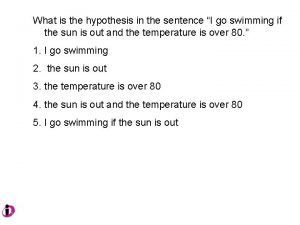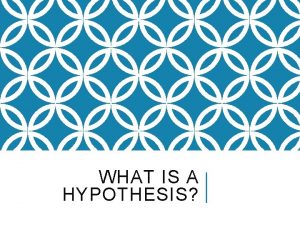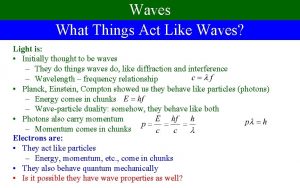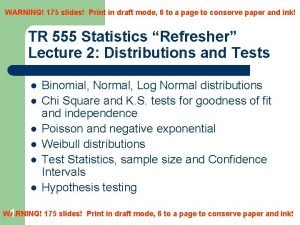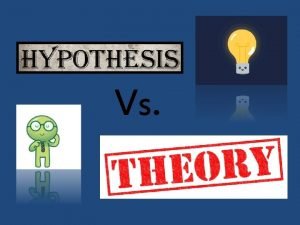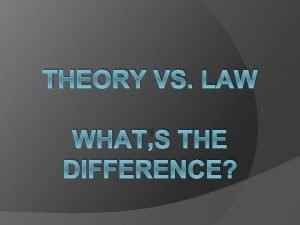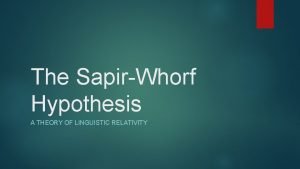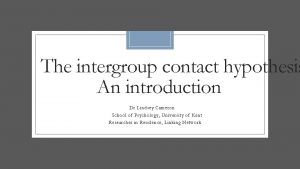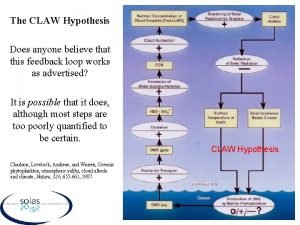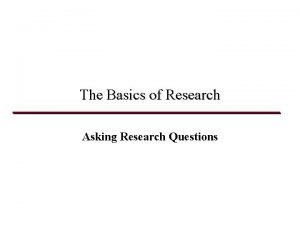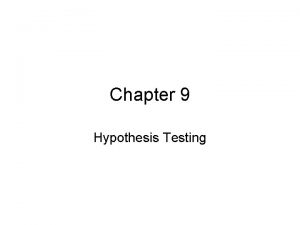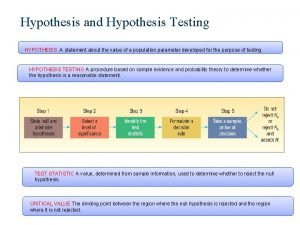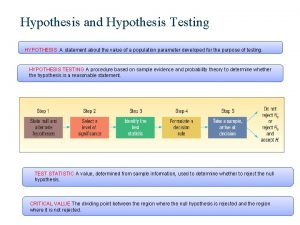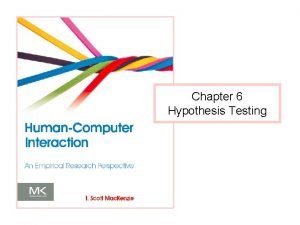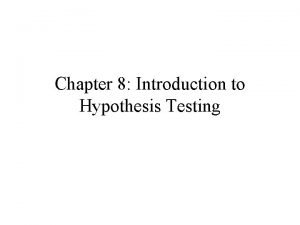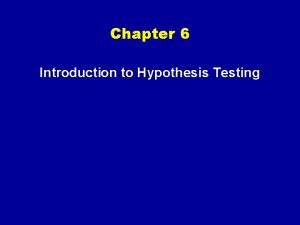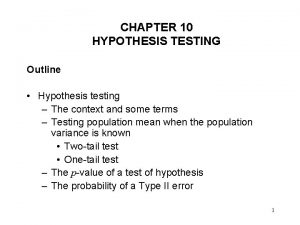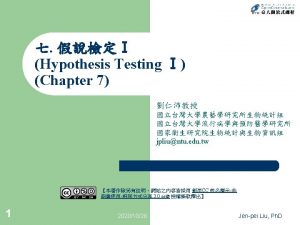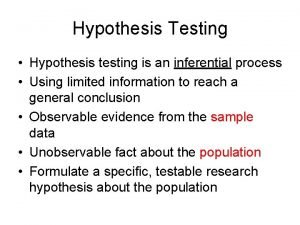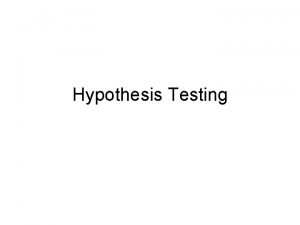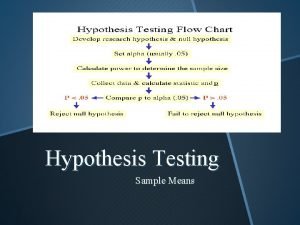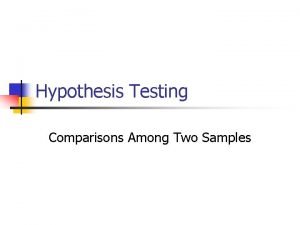Slide 1 Chapter 7 Hypothesis Testing Slide 2
























































































































- Slides: 120

Slide 1

Chapter 7 Hypothesis Testing Slide 2 7 -1 Overview 7 -2 Basics of Hypothesis Testing 7 -3 Testing a Claim About a Proportion 7 -4 Testing a Claim About a Mean: Known 7 -5 Testing a Claim About a Mean: Not Known 7 -6 Testing a Claim About a Standard Deviation or Variance

Slide 3 Section 7 -1 & 7 -2 Overview and Basics of Hypothesis Testing Created by Erin Hodgess, Houston, Texas

Overview Slide 4 Definition v. In statistics, a hypothesis is a claim or statement about a property of a population. v. A hypothesis test (or test of significance) is a standard procedure for testing a claim about a property of a population. Copyright © 2004 Pearson Education, Inc.

Rare Event Rule for Inferential Statistics Slide 5 If, under a given assumption, the probability of a particular observed event is exceptionally small, we conclude that the assumption is probably not correct. Copyright © 2004 Pearson Education, Inc.

Example: Pro. Care Industries, Ltd. , once Slide 6 provided a product called “Gender Choice, ” which, according to advertising claims, allowed couples to “increase your chances of having a boy up to 85%, a girl up to 80%. ” Gender Choice was available in blue packages for couples wanting a baby boy and (you guessed it) pink packages for couples wanting a baby girl. Suppose we conduct an experiment with 100 couples who want to have baby girls, and they all follow the Gender Choice “easy-to-use in-home system” described in the pink package. For the purpose of testing the claim of an increased likelihood for girls, we will assume that Gender Choice has no effect. Using common sense and no formal statistical methods, what should we conclude about the assumption of no effect from Gender Choice if 100 couples using Gender Choice have 100 babies consisting of a) 52 girls? ; b) 97 girls?

Slide 7 Example: Pro. Care Industries, Ltd. : Part a) a) We normally expect around 50 girls in 100 births. The results of 52 girls is close to 50, so we should not conclude that the Gender Choice product is effective. If the 100 couples used no special method of gender selection, the result of 52 girls could easily occur by chance. The assumption of no effect from Gender Choice appears to be correct. There isn’t sufficient evidence to say that Gender Choice is effective.

Slide 8 Example: Pro. Care Industries, Ltd. : Part b) b) The result of 97 girls in 100 births is extremely unlikely to occur by chance. We could explain the occurrence of 97 girls in one of two ways: Either an extremely rare event has occurred by chance, or Gender Choice is effective. The extremely low probability of getting 97 girls is strong evidence against the assumption that Gender Choice has no effect. It does appear to be effective.

7 -2 Section Objectives Slide 9 v Given a claim, identify the null hypothesis, and the alternative hypothesis, and express them both in symbolic form. v Given a claim and sample data, calculate the value of the test statistic. v Given a significance level, identify the critical value(s). v Given a value of the test statistic, identify the P-value. v State the conclusion of a hypothesis test in simple, nontechnical terms. v Identify the type I and type II errors that could be made when testing a given claim. Copyright © 2004 Pearson Education, Inc.

Example: Let’s again refer to the Gender Slide 10 Choice product that was once distributed by Pro. Care Industries claimed that couple using the pink packages of Gender Choice would have girls at a rate that is greater than 50% or 0. 5. Let’s again consider an experiment whereby 100 couples use Gender Choice in an attempt to have a baby girl; let’s assume that the 100 babies include exactly 52 girls, and let’s formalize some of the analysis. Under normal circumstances the proportion of girls is 0. 5, so a claim that Gender Choice is effective can be expressed as p > 0. 5. Using a normal distribution as an approximation to the binomial distribution, we find P(52 or more girls in 100 births) = 0. 3821. continued

Example: Let’s again refer to the Gender Slide 11 Choice product that was once distributed by Pro. Care Industries claimed that couple using the pink packages of Gender Choice would have girls at a rate that is greater than 50% or 0. 5. Let’s again consider an experiment whereby 100 couples use Gender Choice in an attempt to have a baby girl; let’s assume that the 100 babies include exactly 52 girls, and let’s formalize some of the analysis. Figure 7 -1 shows that with a probability of 0. 5, the outcome of 52 girls in 100 births is not unusual. continued

Slide 12 Figure 7 -1 We do not reject random chance as a reasonable explanation. We conclude that the proportion of girls born to couples using Gender Choice is not significantly greater than the number that we would expect by random chance.

Key Points Slide 13 v Claim: For couples using Gender Choice, the proportion of girls is p > 0. 5. v Working assumption: The proportion of girls is p = 0. 5 (with no effect from Gender Choice). v The sample resulted in 52 girls among 100 births, so the sample proportion is p = 52/100 = 0. 52. v Assuming that p = 0. 5, we use a normal distribution as an approximation to the binomial distribution to find that P(at least 52 girls in 100 births) = 0. 3821. v There are two possible explanation for the result of 52 girls in 100 births: Either a random chance event (with probability 0. 3821) has occurred, or the proportion of girls born to couples using Gender Choice is greater than 0. 5. v There isn’t sufficient evidence to support Gender Choice’s claim. Copyright © 2004 Pearson Education, Inc. ˆ

Slide 14 Components of a Formal Hypothesis Test Copyright © 2004 Pearson Education, Inc.

Null Hypothesis: H 0 Slide 15 v. The null hypothesis is a statement about the value of a population parameter. v. It must contain a condition of equality. v =, , or v Test the Null Hypothesis directly v Reject H 0 or fail to reject H 0 Copyright © 2004 Pearson Education, Inc.

Alternative Hypothesis: H 1 Slide 16 v. The alternative hypothesis (denoted by H 1 or Ha) is the statement that the parameter has a value that somehow differs from the null hypothesis. v , <, > Copyright © 2004 Pearson Education, Inc.

Note about Forming Your Own Claims (Hypotheses) Slide 17 If you are conducting a study and want to use a hypothesis test to support your claim, the claim must be worded so that it becomes the alternative hypothesis. Copyright © 2004 Pearson Education, Inc.

Note about Identifying H 0 and H 1 Figure 7 -2 Copyright © 2004 Pearson Education, Inc. Slide 18

Slide 19 Example: Identify the Null and Altenative Hypothesis. Refer to Figure 7 -2 and use the given claims to express the corresponding null and alternative hypotheses in symbolic form. a) The proportion of drivers who admit to running red lights is greater than 0. 5. b) The mean height of professional basketball players is at most 7 ft. c) The standard deviation of IQ scores of actors is equal to 15.

Slide 20 Example: Identify the Null and Altenative Hypothesis. Refer to Figure 7 -2 and use the given claims to express the corresponding null and alternative hypotheses in symbolic form. a) The proportion of drivers who admit to running red lights is greater than 0. 5. In Step 1 of Figure 7 -2, we express the given claim as p > 0. 5. In Step 2, we see that if p > 0. 5 is false, then p 0. 5 must be true. In Step 3, we see that the expression p > 0. 5 does not contain equality, so we let the alternative hypothesis H 1 be p > 0. 5, and we let H 0 be p = 0. 5.

Slide 21 Example: Identify the Null and Altenative Hypothesis. Refer to Figure 7 -2 and use the given claims to express the corresponding null and alternative hypotheses in symbolic form. b) The mean height of professional basketball players is at most 7 ft. In Step 1 of Figure 7 -2, we express “a mean of at most 7 ft” in symbols 7. In Step 2, we see that if 7 is false, then µ > 7 must be true. In Step 3, we see that the expression µ > 7 does not contain equality, so we let the alternative hypothesis H 1 be µ > 0. 5, and we let H 0 be µ 7.

Slide 22 Example: Identify the Null and Altenative Hypothesis. Refer to Figure 7 -2 and use the given claims to express the corresponding null and alternative hypotheses in symbolic form. c) The standard deviation of IQ scores of actors is equal to 15. In Step 1 of Figure 7 -2, we express the given claim as = 15. In Step 2, we see that if = 15 is false, then 15 must be true. In Step 3, we let the alternative hypothesis H 1 be 15, and we let H 0 be = 15.

Test Statistic Slide 23 The test statistic is a value computed from the sample data, and it is used in making the decision about the rejection of the null hypothesis. z=p-p pq n Test statistic for proportions Copyright © 2004 Pearson Education, Inc.

Test Statistic Slide 24 The test statistic is a value computed from the sample data, and it is used in making the decision about the rejection of the null hypothesis. z = x - µx Test statistic for mean n Copyright © 2004 Pearson Education, Inc.

Test Statistic Slide 25 The test statistic is a value computed from the sample data, and it is used in making the decision about the rejection of the null hypothesis. t = x - µx s Test statistic for mean n Copyright © 2004 Pearson Education, Inc.

Test Statistic Slide 26 The test statistic is a value computed from the sample data, and it is used in making the decision about the rejection of the null hypothesis. 2 = (n – 1)s 2 2 Test statistic for standard deviation Copyright © 2004 Pearson Education, Inc.

Example: A survey of n = 880 randomly ˆ Slide 27 selected adult drivers showed that 56%(or p = 0. 56) of those respondents admitted to running red lights. Find the value of the test statistic for the claim that the majority of all adult drivers admit to running red lights. (In Section 7 -3 we will see that there assumptions that must be verified. For this example, assume that the required assumptions are satisfied and focus on finding the indicated test statistic. )

Slide 28 Solution: The preceding example showed that the given claim results in the following null and alternative hypotheses: H 0: p = 0. 5 and H 1: p > 0. 5. Because we work under the assumption that the null hypothesis is true with p = 0. 5, we get the following test statistic: z = p – p = 0. 56 - 0. 5 pq n (0. 5) 880 = 3. 56

Slide 29 Interpretation: We know from previous chapters that a z score of 3. 56 is exceptionally large. It appears that in addition to being “more than half, ” the sample result of 56% is significantly more than 50%. See Figure 7 -3 where we show that the sample proportion of 0. 56 (from 56%) does fall within the range of values considered to be significant because they are so far above 0. 5 that they are not likely to occur by chance (assuming that the population proportion is p = 0. 5).

Slide 30 Figure 7 -3

Critical Region Slide 31 The critical region (or rejection region) is the set of all values of the test statistic that cause us to reject the null hypothesis. For example, see the red-shaded region in Figure 7 -3. Copyright © 2004 Pearson Education, Inc.

Significance Level Slide 32 The significance level (denoted by ) is the probability that the test statistic will fall in the critical region when the null hypothesis is actually true. This is the same introduced in Section 6 -2. Common choices for are 0. 05, 0. 01, and 0. 10. Copyright © 2004 Pearson Education, Inc.

Critical Value Slide 33 A critical value is any value that separates the critical region (where we reject the null hypothesis) from the values of the test statistic that do not lead to rejection of the null hypothesis, the sampling distribution that applies, and the significance level . See Figure 7 -3 where the critical value of z = 1. 645 corresponds to a significance level of = 0. 05. Copyright © 2004 Pearson Education, Inc.

Two-tailed, Right-tailed, Left-tailed Tests The tails in a distribution are the extreme regions bounded by critical values. Copyright © 2004 Pearson Education, Inc. Slide 34

Two-tailed Test H 0: = Slide 35 is divided equally between H 1: the two tails of the critical region Means less than or greater than Copyright © 2004 Pearson Education, Inc.

Right-tailed Test H 0: H 1: > Points Right Copyright © 2004 Pearson Education, Inc. Slide 36

Left-tailed Test H 0: H 1: < Points Left Copyright © 2004 Pearson Education, Inc. Slide 37

P-Value Slide 38 The P-value (or p-value or probability value) is the probability of getting a value of the test statistic that is at least as extreme as the one representing the sample data, assuming that the null hypothesis is true. The null hypothesis is rejected if the P-value is very small, such as 0. 05 or less. Copyright © 2004 Pearson Education, Inc.

Conclusions in Hypothesis Testing v. We always test the null hypothesis. 1. Reject the H 0 2. Fail to reject the H 0 Copyright © 2004 Pearson Education, Inc. Slide 39

Decision Criterion Slide 40 Traditional method: Reject H 0 if the test statistic falls within the critical region. Fail to reject H 0 if the test statistic does not fall within the critical region. Copyright © 2004 Pearson Education, Inc.

Decision Criterion Slide 41 P-value method: Reject H 0 if P-value (where is the significance level, such as 0. 05). Fail to reject H 0 if P-value > . Copyright © 2004 Pearson Education, Inc.

Decision Criterion Slide 42 Another option: Instead of using a significance level such as 0. 05, simply identify the P-value and leave the decision to the reader. Copyright © 2004 Pearson Education, Inc.

Decision Criterion Slide 43 Confidence Intervals: Because a confidence interval estimate of a population parameter contains the likely values of that parameter, reject a claim that the population parameter has a value that is not included in the confidence interval. Copyright © 2004 Pearson Education, Inc.

Example: Finding P-values. Figure 7 -6 Slide 44

Slide 45 Example: Finding P-values. First determine whether the given conditions result in a right-tailed test, a lefttailed test, or a two-tailed test, then find the P-values and state a conclusion about the null hypothesis. a) A significance level of = 0. 05 is used in testing the claim that p > 0. 25, and the sample data result in a test statistic of z = 1. 18. b) A significance level of = 0. 05 is used in testing the claim that p 0. 25, and the sample data result in a test statistic of z = 2. 34.

Slide 46 Example: Finding P-values. First determine whether the given conditions result in a right-tailed test, a lefttailed test, or a two-tailed test, then find the P-values and state a conclusion about the null hypothesis. a) With a claim of p > 0. 25, the test is right-tailed. Because the test is right-tailed, Figure 7 -6 shows that the P-value is the area to the right of the test statistic z = 1. 18. Using the methods of Section 5 -2, we refer to Table A-2 and find that the area to the right of z = 1. 18 is 0. 1190. The P-value is 0. 1190 is greater than the significance level = 0. 05, so we fail to reject the null hypothesis.

Slide 47 Example: Finding P-values. First determine whether the given conditions result in a right-tailed test, a lefttailed test, or a two-tailed test, then find the P-values and state a conclusion about the null hypothesis. b) With a claim of p 0. 25, the test is two-tailed. Because the test is two-tailed, and because the test statistic of z = 2. 34 is to the right of the center, Figure 7 -6 shows that the P-value is twice the area to the right of z = 2. 34. Using the methods of Section 5 -2, we refer to Table A-2 and find that the area to the right of z = 2. 34 is 0. 0096, so P-value = 2 x 0. 0096 = 0. 0192. The P-value of 0. 0192 is less than or equal to the significance level, so we reject the null hypothesis.

Wording of Final Conclusion Figure 7 -7 Copyright © 2004 Pearson Education, Inc. Slide 48

Accept versus Fail to Reject Slide 49 v. Some texts use “accept the null hypothesis. ” v. We are not proving the null hypothesis. v. The sample evidence is not strong enough to warrant rejection (such as not enough evidence to convict a suspect). Copyright © 2004 Pearson Education, Inc.

Type I Error Slide 50 v. A Type I error is the mistake of rejecting the null hypothesis when it is true. v. The symbol (alpha) is used to represent the probability of a type I error. Copyright © 2004 Pearson Education, Inc.

Type II Error Slide 51 v. A Type II error is the mistake of failing to reject the null hypothesis when it is false. v. The symbol (beta) is used to represent the probability of a type II error. Copyright © 2004 Pearson Education, Inc.

Slide 52 Example: Assume that we a conducting a hypothesis test of the claim p > 0. 5. Here are the null and alternative hypotheses: H 0: p = 0. 5, and H 1: p > 0. 5. a) Identify a type I error. b) Identify a type II error.

Slide 53 Example: Assume that we a conducting a hypothesis test of the claim p > 0. 5. Here are the null and alternative hypotheses: H 0: p = 0. 5, and H 1: p > 0. 5. a) A type I error is the mistake of rejecting a true null hypothesis, so this is a type I error: Conclude that there is sufficient evidence to support p > 0. 5, when in reality p = 0. 5.

Slide 54 Example: Assume that we a conducting a hypothesis test of the claim p > 0. 5. Here are the null and alternative hypotheses: H 0: p = 0. 5, and H 1: p > 0. 5. b) A type II error is the mistake of failing to reject the null hypothesis when it is false, so this is a type II error: Fail to reject p = 0. 5 (and therefore fail to support p > 0. 5) when in reality p > 0. 5.

Slide 55 Copyright © 2004 Pearson Education, Inc.

Controlling Type I and Type II Errors Slide 56 v. For any fixed , an increase in the sample size n will cause a decrease in v. For any fixed sample size n , a decrease in will cause an increase in . Conversely, an increase in will cause a decrease in . v. To decrease both and , increase the sample size. Copyright © 2004 Pearson Education, Inc.

Definition Slide 57 Power of a Hypothesis Test The power of a hypothesis test is the probability (1 - ) of rejecting a false null hypothesis, which is computed by using a particular significance level and a particular value of the population parameter that is an alternative to the value assumed true in the null hypothesis. Copyright © 2004 Pearson Education, Inc.

Slide 58 Comprehensive Hypothesis Test Copyright © 2004 Pearson Education, Inc.

Slide 59 Comprehensive Hypothesis Test Copyright © 2004 Pearson Education, Inc.

Comprehensive Hypothesis Test Slide 60 A confidence interval estimate of a population parameter contains the likely values of that parameter. We should therefore reject a claim that the population parameter has a value that is not included in the confidence interval. Copyright © 2004 Pearson Education, Inc.

Comprehensive Hypothesis Test Slide 61 Caution: In some cases, a conclusion based on a confidence interval may be different from a conclusion based on a hypothesis test. See the comments in the individual sections. Copyright © 2004 Pearson Education, Inc.

Slide 62 Section 7 -3 Testing a Claim About a Proportion Created by Erin Hodgess, Houston, Texas

Assumptions for Testing Claims About a Population Proportion p Slide 63 1) The sample observations are a simple random sample. 2) The conditions for a binomial experiment are satisfied (Section 4 -3) Copyright © 2004 Pearson Education, Inc.

Assumptions for Testing Claims About a Population Proportion p Slide 64 1) The sample observations are a simple random sample. 2) The conditions for a binomial experiment are satisfied (Section 4 -3) 3) The condition np 5 and nq 5 are satisfied, so the binomial distribution of sample proportions can be approximated by a normal distribution with µ = np and = npq. Copyright © 2004 Pearson Education, Inc.

Notation Slide 65 n = number of trials p = x (sample proportion) n p = population proportion (used in the null hypothesis) q = 1 – p Copyright © 2004 Pearson Education, Inc.

Test Statistic for Testing a Claim about a Proportion z= p–p pq n Copyright © 2004 Pearson Education, Inc. Slide 66

Traditional Method Slide 67 Use the same method as described in Section 7 -2 and in Figure 7 -8. Copyright © 2004 Pearson Education, Inc.

P-Value Method Slide 68 Use the same method as described in Section 7 -2 and in Figure 7 -6. Use the standard normal distribution (Table A-2). Copyright © 2004 Pearson Education, Inc.

Confidence Interval Method Slide 69 Use the same method as described in Section 7 -2 and in Table 7 -2. Copyright © 2004 Pearson Education, Inc.

Slide 70 Example: In the Chapter Problem, we noted that an article distributed by the Associated Press included these results from a nationwide survey: Of 880 randomly selected drivers, 56% admitted that they run red lights. The claim is that the majority of all Americans run red lights. That is, p > 0. 5. The sample data are n = 880, and p = 0. 56. np = (880)(0. 5) = 440 5 nq = (880)(0. 5) = 440 5

Slide 71 Example: In the Chapter Problem, we noted that an article distributed by the Associated Press included these results from a nationwide survey: Of 880 randomly selected drivers, 56% admitted that they run red lights. The claim is that the majority of all Americans run red lights. That is, p > 0. 5. The sample data are n = 880, and p = 0. 56. We will use the Traditional Method. p–p z= = 0. 56 – 0. 5 = 3. 56 H 0: p = 0. 5 pq H 1: p > 0. 5 (0. 5) = 0. 05 n 880 This is a right-tailed test, so the critical region is an area of 0. 05. We find that z = 1. 645 is the critical value of the critical region. We reject the null hypothesis. There is sufficient evidence to support the claim.

Slide 72 Example: In the Chapter Problem, we noted that an article distributed by the Associated Press included these results from a nationwide survey: Of 880 randomly selected drivers, 56% admitted that they run red lights. The claim is that the majority of all Americans run red lights. That is, p > 0. 5. The sample data are n = 880, and p = 0. 56. We will use the P-value Method. p–p z= = 0. 56 – 0. 5 = 3. 56 H 0: p = 0. 5 pq H 1: p > 0. 5 (0. 5) = 0. 05 n 880 Referring to Table A-2, we see that for values of z = 3. 50 and higher, we use 0. 9999 for the cumulative area to the left of the test statistic. The P-value is 1 – 0. 9999 = 0. 0001.

Slide 73 Example: In the Chapter Problem, we noted that an article distributed by the Associated Press included these results from a nationwide survey: Of 880 randomly selected drivers, 56% admitted that they run red lights. The claim is that the majority of all Americans run red lights. That is, p > 0. 5. The sample data are n = 880, and p = 0. 56. We will use the P-value Method. p–p z= = 0. 56 – 0. 5 = 3. 56 H 0: p = 0. 5 pq H 1: p > 0. 5 (0. 5) = 0. 05 n 880 Since the P-value of 0. 0001 is less than the significance level of = 0. 05, we reject the null hypothesis. There is sufficient evidence to support the claim.

Slide 74 Example: In the Chapter Problem, we noted that an article distributed by the Associated Press included these results from a nationwide survey: Of 880 randomly selected drivers, 56% admitted that they run red lights. The claim is that the majority of all Americans run red lights. That is, p > 0. 5. The sample data are n = 880, and p = 0. 56. We will use the P-value Method. H 0: p = 0. 5 H 1: p > 0. 5 = 0. 05 z = 3. 56

Slide 75 Example: In the Chapter Problem, we noted that an article distributed by the Associated Press included these results from a nationwide survey: Of 880 randomly selected drivers, 56% admitted that they run red lights. The claim is that the majority of all Americans run red lights. That is, p > 0. 5. The sample data are n = 880, and p = 0. 56. We will use the confidence interval method. For a one-tailed hypothesis test with significance level , we will construct a confidence interval with a confidence level of 1 – 2. Using the methods from Section 6 -2, we construct a 90% confidence interval. We obtain 0. 533 < p < 0. 588. We are 90% confident that the true value of p is contained within the limits of 0. 533 and 0. 588. Thus we support the claim that p > 0. 5.

p sometimes is given directly Slide 76 “ 10% of the observed sports cars are red” is expressed as p = 0. 10 Copyright © 2004 Pearson Education, Inc.

p sometimes is given directly Slide 77 “ 10% of the observed sports cars are red” is expressed as p = 0. 10 p sometimes must be calculated “ 96 surveyed households have cable TV and 54 do not” is calculated using p 96 x = = = 0. 64 n (96+54) (determining the sample proportion of households with cable TV) Copyright © 2004 Pearson Education, Inc.

CAUTION Slide 78 When the calculation of p results in a decimal with many places, store the number on your calculator and use all the decimals when evaluating the z test statistic. v Copyright © 2004 Pearson Education, Inc.

CAUTION Slide 79 When the calculation of p results in a decimal with many places, store the number on your calculator and use all the decimals when evaluating the z test statistic. v v Large errors can result from rounding p too much. Copyright © 2004 Pearson Education, Inc.

Example: When Gregory Mendel conducted Slide 80 his famous hybridization experiments with peas, one such experiment resulted in offspring consisting of 428 peas with green pods and 152 peas with yellow pods. According to Mendel’s theory, 1/4 of the offspring peas should have yellow pods. Use a 0. 05 significance level with the P-value method to test the claim that the proportion of peas with yellow pods is equal to 1/4. We note that n = 428 + 152 = 580, so p = 0. 262, and p = 0. 25.

Example: When Gregory Mendel conducted Slide 81 his famous hybridization experiments with peas, one such experiment resulted in offspring consisting of 428 peas with green pods and 152 peas with yellow pods. According to Mendel’s theory, 1/4 of the offspring peas should have yellow pods. Use a 0. 05 significance level with the P-value method to test the claim that the proportion of peas with yellow pods is equal to 1/4. H 0: p = 0. 25 H 1: p 0. 25 n = 580 = 0. 05 p = 0. 262 z= p–p pq n = 0. 262 – 0. 25 = 0. 67 (0. 25)(0. 75) 580 Since this is a two-tailed test, the P-value is twice the area to the right of the test statistic. Using Table A-2, z = 0. 67 is 1 – 0. 7486 = 0. 2514.

Example: When Gregory Mendel conducted Slide 82 his famous hybridization experiments with peas, one such experiment resulted in offspring consisting of 428 peas with green pods and 152 peas with yellow pods. According to Mendel’s theory, 1/4 of the offspring peas should have yellow pods. Use a 0. 05 significance level with the P-value method to test the claim that the proportion of peas with yellow pods is equal to 1/4. H 0: p = 0. 25 H 1: p 0. 25 n = 580 = 0. 05 p = 0. 262 z= p–p pq n = 0. 262 – 0. 25 = 0. 67 (0. 25)(0. 75) 580 The P-value is 2(0. 2514) = 0. 5028. We fail to reject the null hypothesis. There is not sufficient evidence to warrant rejection of the claim that 1/4 of the peas have yellow pods.

Test Statistic for Testing a Claim about a Proportion z= x–µ z = = p–p pq n x – np npq = x – np n n = npq n Copyright © 2004 Pearson Education, Inc. p–p pq n Slide 83

Slide 84 Section 7 -4 Testing a Claim About a Mean: Known Created by Erin Hodgess, Houston, Texas

Assumptions for Testing Claims About Population Means Slide 85 1) The sample is a simple random sample. 2) The value of the population standard deviation is known. 3) Either or both of these conditions is satisfied: The population is normally distributed or n > 30. Copyright © 2004 Pearson Education, Inc.

Test Statistic for Testing a Claim About a Mean (with Known) z = x – µx n Copyright © 2004 Pearson Education, Inc. Slide 86

P-Value Method Slide 87 Use the same method as described in Section 7 -2 and in Figure 7 -6. Use the standard normal distribution (Table A-2). Copyright © 2004 Pearson Education, Inc.

Example: Data Set 4 in Appendix B lists a Slide 88 sample of 106 body temperatures having a mean of 98. 20°F. Assume that the sample is a simple random sample and that the population standard deviation is known to be 0. 62°F. Use a 0. 05 significance level to test the common belief that the mean body temperature of healthy adults is equal to 98. 6°F. Use the P-value method. H 0: = 98. 6 H 1: 98. 6 = 0. 05 x = 98. 2 = 0. 62 z = x – µx n = 98. 2 – 98. 6 0. 62 = – 6. 64 106 This is a two-tailed test and the test statistic is to the left of the center, so the P-value is twice the area to the left of z = – 6. 64. We refer to Table A-2 to find the area to the left of z = – 6. 64 is 0. 0001, so the P-value is 2(0. 0001) = 0. 0002.

Example: Data Set 4 in Appendix B lists a Slide 89 sample of 106 body temperatures having a mean of 98. 20°F. Assume that the sample is a simple random sample and that the population standard deviation is known to be 0. 62°F. Use a 0. 05 significance level to test the common belief that the mean body temperature of healthy adults is equal to 98. 6°F. Use the P-value method. H 0: = 98. 6 H 1: 98. 6 = 0. 05 x = 98. 2 = 0. 62 z = – 6. 64

Example: Data Set 4 in Appendix B lists a Slide 90 sample of 106 body temperatures having a mean of 98. 20°F. Assume that the sample is a simple random sample and that the population standard deviation is known to be 0. 62°F. Use a 0. 05 significance level to test the common belief that the mean body temperature of healthy adults is equal to 98. 6°F. Use the P-value method. H 0: = 98. 6 H 1: 98. 6 = 0. 05 x = 98. 2 = 0. 62 z = – 6. 64 Because the P-value of 0. 0002 is less than the significance level of = 0. 05, we reject the null hypothesis. There is sufficient evidence to conclude that the mean body temperature of healthy adults differs from 98. 6°F.

Example: Data Set 4 in Appendix B lists a Slide 91 sample of 106 body temperatures having a mean of 98. 20°F. Assume that the sample is a simple random sample and that the population standard deviation is known to be 0. 62°F. Use a 0. 05 significance level to test the common belief that the mean body temperature of healthy adults is equal to 98. 6°F. Use the Traditional method. z = – 6. 64 H 0: = 98. 6 H 1: 98. 6 We now find the critical values to be z = – 1. 96 = 0. 05 and z = 1. 96. We would reject the null x = 98. 2 hypothesis, since the test statistic of z = – 6. 64 = 0. 62 would fall in the critical region. There is sufficient evidence to conclude that the mean body temperature of healthy adults differs from 98. 6°F.

Example: Data Set 4 in Appendix B lists a Slide 92 sample of 106 body temperatures having a mean of 98. 20°F. Assume that the sample is a simple random sample and that the population standard deviation is known to be 0. 62°F. Use a 0. 05 significance level to test the common belief that the mean body temperature of healthy adults is equal to 98. 6°F. Use the Confidence Interval method. H 0: = 98. 6 H 1: 98. 6 = 0. 05 x = 98. 2 = 0. 62 For a two-tailed hypothesis test with a 0. 05 significance level, we construct a 95% confidence interval. Use the methods of Section 6 -2 to construct a 95% confidence interval: 98. 08 < < 98. 32 We are 95% confident that the limits of 98. 08 and 98. 32 contain the true value of , so it appears that 98. 6 cannot be the true value of .

Underlying Rationale of Hypotheses Testing Slide 93 v If, under a given observed assumption, the probability of getting the sample is exceptionally small, we conclude that the assumption is probably not correct. v When testing a claim, we make an assumption (null hypothesis) that contains equality. We then compare the assumption and the sample results and we form one of the following conclusions: Copyright © 2004 Pearson Education, Inc.

Underlying Rationale of Hypotheses Testing Slide 94 v If the sample results can easily occur when the assumption (null hypothesis) is true, we attribute the relatively small discrepancy between the assumption and the sample results to chance. v If the sample results cannot easily occur when that assumption (null hypothesis) is true, we explain the relatively large discrepancy between the assumption and the sample by concluding that the assumption is not true. Copyright © 2004 Pearson Education, Inc.

Slide 95 Section 7 -5 Testing a Claim About a Mean: Not Known Created by Erin Hodgess, Houston, Texas

Assumptions for Testing Claims About a Population Mean (with Not Known) Slide 96 1) The sample is a simple random sample. 2) The value of the population standard deviation is not known. 3) Either or both of these conditions is satisfied: The population is normally distributed or n > 30. Copyright © 2004 Pearson Education, Inc.

Test Statistic for Testing a Claim About a Mean (with Not Known) Slide 97 x –µx t= s n P-values and Critical Values v Found in Table A-3 v Degrees of freedom (df) = n – 1 Copyright © 2004 Pearson Education, Inc.

Important Properties of the Student t Distribution Slide 98 1. The Student t distribution is different for different sample sizes (see Figure 6 -5 in Section 6 -4). 2. The Student t distribution has the same general bell shape as the normal distribution; its wider shape reflects the greater variability that is expected when s is used to test . 3. The Student t distribution has a mean of t = 0 (just as the standard normal distribution has a mean of z = 0). 4. The standard deviation of the Student t distribution varies with the sample size and is greater than 1 (unlike the standard normal distribution, which has a = 1). 5. As the sample size n gets larger, the Student t distribution get closer to the normal distribution. Copyright © 2004 Pearson Education, Inc.

Choosing between the Slide 99 Normal and Student t Distributions when Testing a Claim about a Population Mean µ Use the Student t distribution when is not known and either or both of these conditions is satisfied: The population is normally distributed or n > 30. Copyright © 2004 Pearson Education, Inc.

Example: A premed student in a statistics Slide 100 class is required to do a class project. She plans to collect her own sample data to test the claim that the mean body temperature is less than 98. 6°F. After carefully planning a procedure for obtaining a simple random sample of 12 healthy adults, she measures their body temperatures and obtains the results on page 409. Use a 0. 05 significance level to test the claim these body temperatures come from a population with a mean that is less than 98. 6°F. Use the Traditional method. There are no outliers, and based on a histogram and normal quantile plot, we can assume that the data are from a population with a normal distribution. We use the sample data to find n = 12, x = 98. 39, and s = 0. 535.

Example: A premed student in a statistics Slide 101 class is required to do a class project. She plans to collect her own sample data to test the claim that the mean body temperature is less than 98. 6°F. After carefully planning a procedure for obtaining a simple random sample of 12 healthy adults, she measures their body temperatures and obtains the results on page 409. Use a 0. 05 significance level to test the claim these body temperatures come from a population with a mean that is less than 98. 6°F. Use the Traditional method. H 0: = 98. 6 H 1: < 98. 6 = 0. 05 x = 98. 39 s = 0. 535 n = 12 t= x –µx s n 98. 39 - 98. 6 = 0. 535 12 = – 1. 360

Example: A premed student in a statistics Slide 102 class is required to do a class project. She plans to collect her own sample data to test the claim that the mean body temperature is less than 98. 6°F. After carefully planning a procedure for obtaining a simple random sample of 12 healthy adults, she measures their body temperatures and obtains the results on page 409. Use a 0. 05 significance level to test the claim these body temperatures come from a population with a mean that is less than 98. 6°F. Use the Traditional method. H 0: = 98. 6 H 1: < 98. 6 = 0. 05 x = 98. 39 s = 0. 535 n = 12 t = – 1. 360 Because the test statistic of t = – 1. 360 does not fall in the critical region, we fail to reject H 0. There is not sufficient evidence to to support the claim that the sample comes from a population with a mean less than 98. 6°F.

Slide 103 The larger Student t critical value shows that with a small sample, the sample evidence must be more extreme before we consider the difference is significant. Copyright © 2004 Pearson Education, Inc.

P-Value Method Slide 104 v. Table A-3 includes only selected values of . v. Specific P-values usually cannot be found. v. Use Table to identify limits that contain the P-value. v. Some calculators and computer programs will find exact P-values. Copyright © 2004 Pearson Education, Inc.

Slide 105 Example: Assuming that neither software nor a TI-83 Plus calculator is available, use Table A-3 to find a range of values for the P-value corresponding to the given results. a) In a left-tailed hypothesis test, the sample size is n = 12, and the test statistic is t = – 2. 007. b) In a right-tailed hypothesis test, the sample size is n = 12, and the test statistic is t = 1. 222. c) In a two-tailed hypothesis test, the sample size is n = 12, and the test statistic is t = – 3. 456.

Slide 106 Example: Assuming that neither software nor a TI-83 Plus calculator is available, use Table A-3 to find a range of values for the P-value corresponding to the given results.

Slide 107 Example: Assuming that neither software nor a TI-83 Plus calculator is available, use Table A-3 to find a range of values for the P-value corresponding to the given results. a) The test is a left-tailed test with test statistic t = – 2. 007, so the P-value is the area to the left of – 2. 007. Because of the symmetry of the t distribution, that is the same as the area to the right of +2. 007. Any test statistic between 2. 201 and 1. 796 has a right-tailed P-value that is between 0. 025 and 0. 05. We conclude that 0. 025 < P-value < 0. 05.

Slide 108 Example: Assuming that neither software nor a TI-83 Plus calculator is available, use Table A-3 to find a range of values for the P-value corresponding to the given results. b) The test is a right-tailed test with test statistic t = 1. 222, so the P-value is the area to the right of 1. 222. Any test statistic less than 1. 363 has a right-tailed P-value that is greater than 0. 10. We conclude that P-value > 0. 10.

Slide 109 Example: Assuming that neither software nor a TI-83 Plus calculator is available, use Table A-3 to find a range of values for the P-value corresponding to the given results. c) The test is a two-tailed test with test statistic t = – 3. 456. The P-value is twice the area to the right of – 3. 456. Any test statistic greater than 3. 106 has a two-tailed P-value that is less than 0. 01. We conclude that P-value < 0. 01.

Slide 110 Section 7 -6 Testing a Claim About a Standard Deviation or Variance Created by Erin Hodgess, Houston, Texas

Assumptions for Testing Claims About or 2 Slide 111 1. The sample is a simple random sample. 2) The population has values that are normally distributed (a strict requirement). Copyright © 2004 Pearson Education, Inc.

Chi-Square Distribution Test Statistic 2 = (n – 1) s 2 2 Copyright © 2004 Pearson Education, Inc. Slide 112

Chi-Square Distribution Test Statistic 2 = n s 2 (n – 1) s 2 2 = sample size = sample variance 2 = population variance (given in null hypothesis) Copyright © 2004 Pearson Education, Inc. Slide 113

P-values and Critical Values for Chi-Square Distribution v. Use Table A-4. v. The degrees of freedom = n – 1. Copyright © 2004 Pearson Education, Inc. Slide 114

Properties of Chi-Square Distribution Slide 115 v. All values of 2 are nonnegative, and the distribution is not symmetric (see Figure 7 -12). v. There is a different distribution for each number of degrees of freedom (see Figure 7 -13). v. The critical values are found in Table A-4 using n – 1 degrees of freedom. Copyright © 2004 Pearson Education, Inc.

Properties of Chi-Square Distribution Properties of the Chi-Square Distribution Slide 116 Chi-Square Distribution for 10 and 20 Degrees of Freedom There is a different distribution for each number of degrees of freedom. Figure 7 -13 Figure 7 -12 Copyright © 2004 Pearson Education, Inc.

Slide 117 Example: For a simple random sample of adults, IQ scores are normally distributed with a mean of 100 and a standard deviation of 15. A simple random sample of 13 statistics professors yields a standard deviation of s = 7. 2. Assume that IQ scores of statistics professors are normally distributed and use a 0. 05 significance level to test the claim that = 15. H 0: = 15 H 1: 15 = 0. 05 n = 13 s = 7. 2 2 = (n – 1) s 2 2 2 (13 – 1)(7. 2) = = 2. 765 152 Copyright © 2004 Pearson Education, Inc.

Slide 118 Example: For a simple random sample of adults, IQ scores are normally distributed with a mean of 100 and a standard deviation of 15. A simple random sample of 13 statistics professors yields a standard deviation of s = 7. 2. Assume that IQ scores of statistics professors are normally distributed and use a 0. 05 significance level to test the claim that = 15. H 0: = 15 H 1: 15 = 0. 05 n = 13 s = 7. 2 2 = 2. 765 Copyright © 2004 Pearson Education, Inc.

Slide 119 Example: For a simple random sample of adults, IQ scores are normally distributed with a mean of 100 and a standard deviation of 15. A simple random sample of 13 statistics professors yields a standard deviation of s = 7. 2. Assume that IQ scores of statistics professors are normally distributed and use a 0. 05 significance level to test the claim that = 15. H 0: = 15 H 1: 15 = 0. 05 n = 13 s = 7. 2 2 = 2. 765 The critical values of 4. 404 and 23. 337 are found in Table A-4, in the 12 th row (degrees of freedom = n – 1) in the column corresponding to 0. 975 and 0. 025. Copyright © 2004 Pearson Education, Inc.

Slide 120 Example: For a simple random sample of adults, IQ scores are normally distributed with a mean of 100 and a standard deviation of 15. A simple random sample of 13 statistics professors yields a standard deviation of s = 7. 2. Assume that IQ scores of statistics professors are normally distributed and use a 0. 05 significance level to test the claim that = 15. H 0: = 15 H 1: 15 = 0. 05 n = 13 s = 7. 2 2 = 2. 765 Because the test statistic is in the critical region, we reject the null hypothesis. There is sufficient evidence to warrant rejection of the claim that the standard deviation is equal to 15. Copyright © 2004 Pearson Education, Inc.
 Chapter 8 hypothesis testing
Chapter 8 hypothesis testing Chapter 7 hypothesis testing with one sample answers
Chapter 7 hypothesis testing with one sample answers Heel toe polka dance steps
Heel toe polka dance steps Null and research hypotheses
Null and research hypotheses Null hypothesis vs alternative hypothesis
Null hypothesis vs alternative hypothesis Null hypothesis example
Null hypothesis example Nebular hypothesis and protoplanet hypothesis venn diagram
Nebular hypothesis and protoplanet hypothesis venn diagram The language of hypothesis testing
The language of hypothesis testing Inference hypothesis testing
Inference hypothesis testing One way anova test
One way anova test Hypothesis testing assignment
Hypothesis testing assignment Hypothesis testing
Hypothesis testing Critical value hypothesis testing
Critical value hypothesis testing Hypothesis test assumptions
Hypothesis test assumptions Critical value hypothesis testing
Critical value hypothesis testing Goal of hypothesis testing
Goal of hypothesis testing Hypothesis testing definition
Hypothesis testing definition Hypothesis test statistics formula
Hypothesis test statistics formula 6 steps of hypothesis testing
6 steps of hypothesis testing What is the claim in hypothesis testing
What is the claim in hypothesis testing Hypothesis testing flow diagram
Hypothesis testing flow diagram Hypothesis testing for population proportion
Hypothesis testing for population proportion Slope hypothesis testing
Slope hypothesis testing Business statistics hypothesis testing
Business statistics hypothesis testing Hypothesis testing a level maths
Hypothesis testing a level maths Testing the manifold hypothesis
Testing the manifold hypothesis Hypothesis testing in r
Hypothesis testing in r Phantoms hypothesis testing
Phantoms hypothesis testing Hypothesis testing in r
Hypothesis testing in r One-way anova hypothesis testing
One-way anova hypothesis testing How to test hypothesis in excel
How to test hypothesis in excel Create a meme about concepts in hypothesis testing
Create a meme about concepts in hypothesis testing Hypothesis testing for variance
Hypothesis testing for variance Finding test statistic
Finding test statistic H0no
H0no Statistical test meaning
Statistical test meaning Causal hypothesis testing
Causal hypothesis testing Kari is testing the hypothesis
Kari is testing the hypothesis Example of null hypothesis
Example of null hypothesis Logic of hypothesis testing
Logic of hypothesis testing Hypothesis
Hypothesis Two sided p value
Two sided p value Hypothesis testing business statistics
Hypothesis testing business statistics Kari is testing the hypothesis
Kari is testing the hypothesis Kari is testing the hypothesis
Kari is testing the hypothesis Kari is testing the hypothesis
Kari is testing the hypothesis Confidence interval vs hypothesis testing
Confidence interval vs hypothesis testing Limitations of hypothesis testing
Limitations of hypothesis testing Steps in hypothesis testing ppt
Steps in hypothesis testing ppt Hypothesis testing
Hypothesis testing Hypothesis testing adalah
Hypothesis testing adalah Null hypothesis example
Null hypothesis example Hypothesis testing t test formula
Hypothesis testing t test formula Hypothesis test statistics
Hypothesis test statistics General problem in research example
General problem in research example Define null hypothesis
Define null hypothesis Hypothesis testing mean
Hypothesis testing mean Hypothesis testing
Hypothesis testing Hypothesis example
Hypothesis example Testing of hypothesis
Testing of hypothesis What is ho and ha
What is ho and ha Example of a hypothesis
Example of a hypothesis Testing hypothesis
Testing hypothesis Hypothesis testing
Hypothesis testing What is hypothesis testing
What is hypothesis testing Fundamentals of hypothesis testing
Fundamentals of hypothesis testing Domain test means
Domain test means Motivational overview of logic based testing
Motivational overview of logic based testing Data flow testing strategies in software testing
Data flow testing strategies in software testing Positive vs negative testing
Positive vs negative testing Cs 3250
Cs 3250 Anuj magazine
Anuj magazine Functional testing vs unit testing
Functional testing vs unit testing Decision table testing in software testing
Decision table testing in software testing Control structure testing in software testing
Control structure testing in software testing Decision table testing in software testing
Decision table testing in software testing Decision table testing examples
Decision table testing examples Makalah black box testing
Makalah black box testing Black-box testing disebut juga sebagai behavioral testing
Black-box testing disebut juga sebagai behavioral testing Extended entry decision table
Extended entry decision table Rigorous testing in software testing
Rigorous testing in software testing Testing blindness in software testing
Testing blindness in software testing Component testing is a black box testing
Component testing is a black box testing Types of domain testing
Types of domain testing Factor
Factor Chapter 6 employee testing and selection ppt
Chapter 6 employee testing and selection ppt Chapter 34 collecting and testing specimens
Chapter 34 collecting and testing specimens Chapter 30 inspecting and testing welds
Chapter 30 inspecting and testing welds Chapter 20 testing hypotheses about proportions
Chapter 20 testing hypotheses about proportions Chapter 8 software testing
Chapter 8 software testing Chapter 19 testing hypotheses about proportions
Chapter 19 testing hypotheses about proportions Chapter 51 battery testing and service
Chapter 51 battery testing and service Chapter 20 testing hypotheses about proportions
Chapter 20 testing hypotheses about proportions Chapter 23 specimen collection and diagnostic testing
Chapter 23 specimen collection and diagnostic testing Chapter 24 diagnostic tests and specimen collection
Chapter 24 diagnostic tests and specimen collection How do you write a testable hypothesis
How do you write a testable hypothesis Characteristics of hypothesis
Characteristics of hypothesis Riemann hypothesis graph
Riemann hypothesis graph Hypothesis starters
Hypothesis starters If then because hypothesis
If then because hypothesis What is a hypothesis? *
What is a hypothesis? * If then because hypothesis
If then because hypothesis De broglie hypothesis
De broglie hypothesis Working hypothesis example
Working hypothesis example Theory vs hypothesis
Theory vs hypothesis Meaning of hypothesis in research
Meaning of hypothesis in research Church turing hypothesis
Church turing hypothesis Traditional media strategy
Traditional media strategy Definition of linguistic determinism
Definition of linguistic determinism Whats scientific law
Whats scientific law If then because hypothesis
If then because hypothesis Question hypothesis experiment data conclusion
Question hypothesis experiment data conclusion If then because hypothesis
If then because hypothesis Sapir-whorf hypothesis definition
Sapir-whorf hypothesis definition Ding dong hypothesis
Ding dong hypothesis Allport's contact hypothesis
Allport's contact hypothesis The gaia hypothesis
The gaia hypothesis Evidence supporting efficient market hypothesis
Evidence supporting efficient market hypothesis Claw hypothesis
Claw hypothesis Define biogenesis
Define biogenesis Directional hypothesis example
Directional hypothesis example
